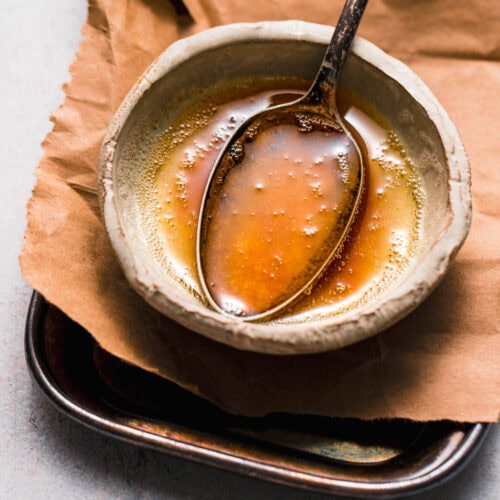
Browned Butter
Servings: 8 people
Calories: 203kcal
Watch as I show you how to make a one-pan wonder for almost any dish with Browned Butter! That’s right, this simple technique transforms regular butter into something truly magical with deep, nutty, flavor. Even better, it only takes a few minutes on the stove!
Print Recipe
Equipment
Ingredients
- 1 cup unsalted butter 2 sticks
Instructions
- Melt butter in a heavy, large saucepan over medium heat. Cook until butter solids are golden brown, swirling pan occasionally, about 5 minutes.
- Note: Don’t stir the butter too much or it will prevent it from browning. Keep an eye on it so that it doesn’t burn.
Notes
Storing
- Browned butter will naturally solidify when it returns to room temperature. Once solidified, wrap it tightly in plastic wrap and store it in the fridge for up to 2 weeks or in the freezer for up to 3 months.
- You can pour the browned butter into an ice cube tray to freeze. Once frozen, transfer the cubes to a sealable freezer bag or container.
- Gently reheat your stored browned butter in a pan over low heat.
- Cut the sticks of butter into smaller pieces for even cooking.
- Allow the butter to sit at room temperature for about 20-25 minutes before heating it in the pan. If the butter is too cold from the fridge or if it is frozen, it will splatter and burn easily.
- Use a light pan so that you can see when the butter is browning.
- Melt the butter over medium heat to ensure that it cooks evenly to achieve the desired browning.
- Keep a close watch on the butter as browned butter can turn to burnt butter very quickly.
- You will know that the butter is done browning when some of the foam in the melted butter begins to dissolve and brown specks (toasted milk solids) appear on the bottom of the pan.
- Stop the butter from cooking further by immediately removing it from the hot pan and transferring it to a heat-proof bowl or glass jar. If left in the pan, it will continue to cook and potentially burn.
- Scrape all the brown specks out of the pan along with the melted butter as these toasted milk solids hold the most flavor. Don’t strain them out of the browned butter.
- Always measure the browned butter for recipes as there will naturally be some moisture lost from the evaporation while the butter cooks.
- Stir the melted butter regularly while on the stovetop so that it cooks evenly.
- Don’t bake with hot browned butter as this will affect the sugar and other ingredients, causing them to dissolve too quickly and ultimately changing the texture and structure of your baked goods.
- Salted brown butter - Whether you use salted or unsalted butter depends on what you are using this butter for. I recommend unsalted browned butter for incorporating into your baking. Salted butter is a delicious alternative for making savory and rich sauces or gravy.
- Make a double batch - Easily make a double batch of browned butter by simply doubling the butter called for in this recipe, if needed. Keep in mind that more butter will require an extended cook time. Likewise, less butter will require a reduced cook time.
- Savory variations - Mix in some chopped herbs, minced garlic, lemon juice or zest, finely minced shallots, or savory seasonings and spices.
- Sweet variations - Mix in a splash of vanilla extract, maple syrup or honey, cinnamon, and a pinch of brown sugar.
Nutrition
Calories: 203kcal | Carbohydrates: 0.02g | Protein: 0.2g | Fat: 23g | Saturated Fat: 15g | Polyunsaturated Fat: 1g | Monounsaturated Fat: 6g | Trans Fat: 1g | Cholesterol: 61mg | Sodium: 3mg | Potassium: 7mg | Sugar: 0.02g | Vitamin A: 709IU | Calcium: 7mg | Iron: 0.01mg